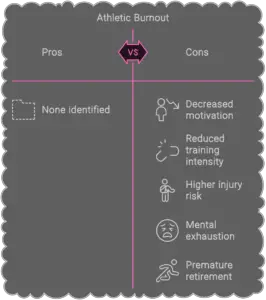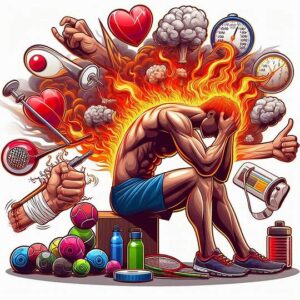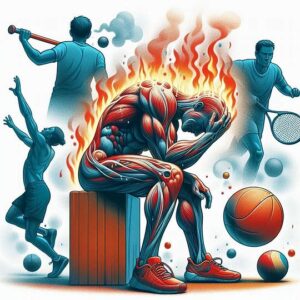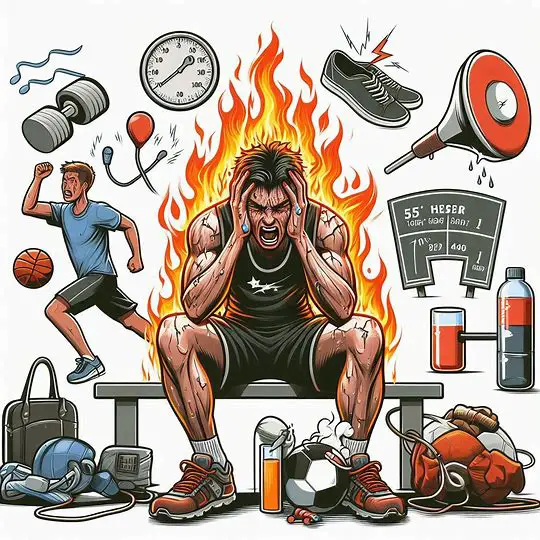
Table of Contents
Introduction – Signs of Burnout in Sports
Burnout in athletics can present as mental, emotional, and physical exhaustion, adversely affecting performance and leading to increased mistakes, demotivation, and even premature retirement. It’s not just a decline in physical capabilities but also encompasses diminished mental enthusiasm that reflects in underwhelming performances. Early identification of burnout signs is crucial as it creates a dangerous cycle of underperformance and further exhaustion, thereby hampering overall performance and well-being.
As an athlete, you’re no stranger to pushing your body to its limits. You’re accustomed to the sweat, the tears, and the endless hours of practice. But when does dedication cross the line into burnout? Burnout in sports is a common phenomenon affecting athletes of all levels and backgrounds. It’s a state of emotional, mental, and physical exhaustion that can creep up on you suddenly, derailing your performance and overall well-being. In this article, we’ll delve into the signs of burnout in sports and why it’s essential to recognize them early on.
The Impact of Burnout on Athletic Performance
Before we discuss the signs of burnout, it’s essential to understand its significant impact on athletic performance. Burnout can lead to decreased motivation, reduced training intensity, and a higher risk of injury. It also increases the likelihood of making mistakes, losing focus, and struggling to recover from setbacks. In extreme cases, burnout can even lead to premature retirement from the sport.
Burnout impacts not just your physical capabilities but also your mental acuity. Athletes suffering from burnout often report a lack of enthusiasm, translating into lacklustre performances. For instance, a runner might be unable to hit their usual pace, or a swimmer might struggle to maintain their technique. The diminished performance can be incredibly frustrating, creating a vicious cycle of underperformance and further mental exhaustion.
Moreover, burnout often increases the likelihood of errors during practice and competitions. When your mind is not fully engaged, simple mistakes can multiply, affecting your overall performance. This can be particularly dangerous in high-stakes situations where precision and focus are crucial. A gymnast, for example, might miss a routine element, or a basketball player might make poor decisions under pressure.
Another significant impact of burnout is the prolonged recovery time from physical and mental setbacks. Injuries that would typically heal quickly may linger, and mental slumps may become more challenging to overcome. This can create a snowball effect, where the accumulated stress and pressure make it increasingly challenging to bounce back.
Finally, burnout affects your performance and can negatively affect your athletic career. Chronic burnout can lead to permanent physical issues and even force athletes into early retirement. The impact on mental health can be equally severe, contributing to conditions like anxiety and depression that can outlast your athletic career.

Physical Signs of Burnout
Burnout can manifest physically, making it essential to monitor your body’s response to the demands of your sport.
Fatigue: Feeling constantly exhausted, even after adequate rest and recovery.
Injuries: Persistent or recurring injuries that don’t seem to heal or new ones that keep popping up.
Changes in Appetite or Sleep: Loss of interest in food or difficulty sleeping, leading to weight changes or insomnia.
Digestive Issues: Chronic stomach problems, diarrhea, or Irritable Bowel Syndrome (IBS).
Weakened Immune System: Frequent illnesses or infections that take longer to recover from.
Pain and Discomfort: Chronic pain or discomfort in your muscles, joints, or bones.
Common Physical Symptoms of Burnout in Specific Sports
Different sports can lead to unique physical symptoms of burnout. For example:
Endurance Athletes: Runners, cyclists, and swimmers may experience chronic fatigue, muscular cramps, or tendonitis.
Contact Sports: Football, rugby, and hockey players may experience recurring concussions, joint pain, or ligament sprains.
High-Impact Sports: Gymnasts, dancers, and figure skaters may experience chronic joint pain, stress fractures, or tendonitis.
Endurance athletes often push their bodies to the brink, making them particularly susceptible to physical burnout. Chronic fatigue is a common complaint, where rest no longer seems to rejuvenate the body. Muscular cramps may become more frequent and severe, hampering training and performance. Tendonitis, a common overuse injury, can sideline athletes for extended periods, disrupting their training schedules.
The risk of physical burnout manifests differently for those engaged in contact sports. Recurring concussions are a severe concern, leading to long-term cognitive issues. Joint pain can become a persistent problem, affecting mobility and performance. Ligament sprains, often seen in sports like football and rugby, can be debilitating and require extensive recovery.
Athletes in high-impact sports such as gymnastics, dance, and figure skating face challenges. Chronic joint pain is a frequent issue due to the repetitive stress placed on the body. Stress fractures are not uncommon and can sideline an athlete for months. Tendonitis is another frequent complaint, requiring careful management to prevent further damage.
Emotional and Mental Signs of Burnout
Burnout can also affect one’s emotional and mental state, affecting motivation and overall enjoyment of the sport.
Loss of Motivation: Feeling unenthusiastic or disconnected from your sport, despite previous passion and dedication.
Irritability: Becoming short-tempered or restless, even with minor setbacks or frustrations.
Anxiety or Depression: Feeling overwhelmed, hopeless, or helpless, leading to anxiety or depression.
Detachment: Feeling isolated or disconnected from teammates, coaches, or the sporting community.
Decreased Self-Esteem: Feeling inadequate, incompetent, or unworthy, leading to self-doubt and negativity.
Fear of Failure: Fear of not meeting expectations or fear of failure, leading to anxiety and performance pressure.
Athletes experiencing burnout often report a dramatic loss of motivation. Activities that once brought joy and satisfaction can begin to feel like a chore. This lack of enthusiasm can make maintaining the rigorous training schedules required for peak performance difficult. The once clear goals and aspirations may start to feel distant and unattainable.
Irritability is another emotional symptom of burnout. The constant fatigue and stress can make athletes short-tempered and restless. Even minor setbacks or frustrations can trigger disproportionate responses, affecting relationships with coaches, teammates, and family members. This irritability can create a negative feedback loop, further isolating the athlete from their support network.
Anxiety and depression are severe emotional manifestations of burnout. The overwhelming sense of hopelessness and helplessness can make focusing on training and performance difficult. Anxiety can exacerbate performance pressure, leading to a decline in both physical and mental capabilities. Depression can sap the energy and willpower needed to continue competing at a high level.
Detachment is another common emotional sign of burnout. Athletes may feel isolated or disconnected from their teammates, coaches, and the broader sporting community. This sense of detachment can make staying engaged and committed to the sport challenging. The lack of a supportive environment can further exacerbate isolation and loneliness.
Decreased self-esteem is a critical emotional symptom of burnout. Athletes may feel inadequate, incompetent, or unworthy, leading to self-doubt and negativity. This decrease in self-esteem can be particularly damaging, affecting athletic performance and overall mental health. The fear of failure can become overwhelming, creating a cycle of anxiety and underperformance.
Behavioral Signs of Burnout

Changes in your behavior can also indicate burnout, including:
Reduced Training: Slacking off or consistently missing training sessions despite previous commitments.
Social Withdrawal: Withdrawing from social engagements, fearing interactions with teammates or coaches.
Procrastination: Putting off tasks or decisions leads to stagnation and lack of progress.-
Substance Abuse: Relying on substances to cope with stress, emotional pain, or performance pressure.
Changes in Eating Habits: Using food as a coping mechanism, leading to unhealthy eating habits or disordered eating.
Neglecting Responsibilities: Ignoring responsibilities, such as schoolwork, work, or family obligations, due to burnout.
Reduced training is a common behavioral sign of burnout. Athletes may find themselves slacking off or consistently missing training sessions. This behavior is often at odds with their previous level of commitment and can be a red flag that something is amiss. The lack of training can further exacerbate physical and emotional symptoms, creating a downward spiral.
Social withdrawal is another behavioral symptom of burnout. Athletes may start to withdraw from social engagements, fearing interactions with teammates or coaches. This withdrawal can lead to a sense of isolation, making it even more challenging to deal with the symptoms of burnout. The lack of a supportive social network can make recovery more difficult.
Procrastination is a less obvious but equally significant behavioral sign of burnout. Athletes may start putting off tasks or decisions, leading to stagnation and lack of progress. This procrastination can affect their athletic performance and other areas of their life, such as academics or work. The inability to take action can be paralyzing and further exacerbate feelings of inadequacy.
Substance abuse is a serious behavioral symptom of burnout. Some athletes may turn to substances to cope with the stress, emotional pain, or performance pressure. This reliance can be incredibly damaging, affecting their athletic career and overall health and well-being. Substance abuse can create a cycle of dependency, making recovery even more challenging.
Changes in eating habits are another behavioral sign of burnout. Athletes may use food as a coping mechanism, leading to unhealthy eating habits or disordered eating. This can severely affect their physical health, affecting performance and recovery. The emotional and mental toll of disordered eating can further exacerbate the symptoms of burnout.
Neglecting responsibilities is a final behavioral sign of burnout. Athletes may start to ignore responsibilities such as schoolwork, work, or family obligations. This neglect can create additional stress and anxiety, further contributing to the symptoms of burnout. The inability to balance different aspects of life can significantly indicate something is wrong.
Why Burnout Matters
Burnout is not just a personal issue; it can have far-reaching consequences for your athletic career and overall well-being.
Performance Decline: Burnout can lead to decreased performance, loss of confidence, and reduced competitiveness.
Injury Risk: Burnout can increase the risk of injury, as mental fatigue impairs focus and judgment.
Mental Health: Chronic burnout can contribute to the development of anxiety, depression, or other mental health issues.
Career Burnout: Severe burnout can lead to premature retirement or abandonment of the sport altogether.
Impact on Personal Relationships: Burnout can affect relationships with family, friends, and teammates, leading to social isolation.
Long-Term Consequences: Chronic burnout can lead to long-term health consequences, such as cardiovascular disease, chronic fatigue, or adrenal insufficiency.
Performance decline is one of the most immediate and noticeable consequences of burnout. Athletes experiencing burnout often report a significant drop in performance levels. This decline can be incredibly frustrating, leading to a loss of confidence and reduced competitiveness. The inability to perform at your best can be a significant blow to your self-esteem and overall career prospects.
Increased injury risk is another critical consequence of burnout. Mental fatigue impairs focus and judgment, making athletes more susceptible to injuries. The lack of proper recovery can exacerbate existing injuries, leading to longer downtime and more extended recovery periods. This increased risk can have a long-term impact on an athlete’s career.
Mental health is another area severely affected by chronic burnout. The prolonged stress and emotional exhaustion can contribute to the development of anxiety, depression, or other mental health issues. These conditions can be debilitating, affecting athletic performance and overall quality of life. The mental toll of burnout can outlast the physical symptoms, creating long-term challenges.
Career burnout is a severe consequence that can lead to premature retirement or abandonment of the sport altogether. The inability to perform at desired levels, coupled with the mental and emotional toll, can make it difficult to continue competing. Early retirement due to burnout can be a significant loss for the athlete and the sport as a whole.
Burnout can also profoundly impact personal relationships. The emotional and mental toll can strain relationships with family, friends, and teammates. Social isolation can exacerbate feelings of loneliness and detachment, making it even more challenging to recover from burnout. The support network athletes rely on can become strained, further complicating the recovery process.
Another significant concern is the long-term health consequences. Chronic burnout can lead to severe health issues such as cardiovascular disease, chronic fatigue, or adrenal insufficiency. These conditions can have a lasting impact on an athlete’s overall health and well-being. The long-term consequences of burnout extend far beyond the immediate symptoms, affecting overall quality of life.
Prevention and Recovery
Recognizing the signs of burnout is just the first step. To prevent or recover from burnout, it’s essential to:
Prioritize Self-Care: Make time for activities that bring joy and relaxation outside of the sport.
Set Realistic Goals: Establish achievable goals and celebrate small victories to maintain motivation.
Seek Support: Surround yourself with a support network of coaches, teammates, and mental health professionals.
Take Breaks: Allow yourself time to rest and recover, both physically and mentally.
Re-evaluate Your Priorities: Identify the sources of burnout and reassess your priorities to prevent future burnout.
Seek Professional Help: Consult with a mental health professional or sports psychologist to develop coping strategies and recovery plans.
Prioritizing self-care is a crucial step in preventing and recovering from burnout. Make time for activities that bring joy and relaxation outside of the sport. This can help create a healthy balance and provide a mental break from the constant pressures of training and competition. Activities like reading, spending time with loved ones, or engaging in a hobby can be incredibly rejuvenating.
Setting realistic goals is another important strategy. Establish achievable goals and celebrate small victories to maintain motivation. This can help create a sense of accomplishment and keep you engaged in your sport. Unrealistic expectations can contribute to burnout, so it’s essential to set challenging yet attainable goals.
Seeking support is vital in both preventing and recovering from burnout. Surround yourself with a support network of coaches, teammates, and mental health professionals. This network can provide the emotional and mental support needed to navigate the challenges of burnout. Don’t hesitate to seek help; a strong support system can make a significant difference.
Taking breaks is another essential strategy. Allow yourself time to rest and recover, both physically and mentally. Scheduled breaks can help prevent burnout by providing time to recharge. Listen to your body and mind; if you feel overwhelmed, take a step back and allow yourself time to recover.
Re-evaluating your priorities can also help prevent burnout. Identify the sources of burnout and reassess your priorities to prevent future burnout. This may involve changing your training schedule, setting new goals, or focusing on different aspects of your life. Understanding what is causing burnout can help you take proactive steps to address it.
Seeking professional help is another important step. Consult a mental health professional or sports psychologist to develop coping strategies and recovery plans. These professionals can provide valuable insights and tools to help you manage and prevent burnout from recurring. Don’t hesitate to seek professional help; taking care of your mental health is just as important as your physical health.
Recovery Strategies for Burnout
Recovering from burnout requires a comprehensive approach that addresses physical, emotional, and mental exhaustion.
Gradual Return to Training: Gradually return to training, starting with low-intensity exercises and progressing to more demanding activities.
Sleep and Rest: Prioritize sleep and rest, aiming for 7-9 hours each night and taking regular breaks during the day.
Nutrition and Hydration: Focus on proper nutrition and hydration, avoiding processed foods and sugary drinks.
Mental Skills Training: To improve mental resilience, engage in mental skills training, such as mindfulness, meditation, or visualization.
Time Management: Develop effective time management skills, prioritizing tasks and avoiding overcommitting.
Social Support: Surround yourself with a supportive network of family, friends, and teammates.
Gradual return to training is a crucial recovery strategy. Start with low-intensity exercises and gradually progress to more demanding activities. This approach allows your body and mind to adjust and recover sustainably. Pushing too hard too soon can exacerbate burnout, so taking a measured approach is essential.
Another critical recovery strategy is prioritizing sleep and rest. Aim for 7-9 hours of sleep each night and take regular breaks during the day. Quality sleep is essential for both physical and mental recovery. Establish a consistent sleep routine to ensure you get the rest needed to recover from burnout.
Nutrition and hydration play a vital role in recovery. Focus on proper nutrition and hydration, avoiding processed foods and sugary drinks. A balanced diet rich in vitamins, minerals, and antioxidants can help support recovery. Staying hydrated is equally important for overall health and well-being.
Engaging in mental skills training can improve mental resilience. Mindfulness, meditation, or visualization can help manage stress and enhance mental toughness. These skills can provide valuable tools to navigate the challenges of burnout and improve overall mental health.
Effective time management is also essential for recovery. Develop skills that help you prioritize tasks and avoid overcommitting. This can help create a balanced schedule that allows time for training, rest, and other important aspects of life. Avoiding overcommitment can reduce stress and prevent future burnout.
Social support is the final key to recovery. Surround yourself with a supportive network of family, friends, and teammates. This support network can provide emotional and mental support, helping you navigate the challenges of burnout. Don’t hesitate to lean on your support system; having a strong network can significantly affect your recovery process.
By being attuned to the signs of burnout and taking proactive steps to prevent it, you can maintain your physical and mental well-being and ensure a long and successful athletic career. Remember, taking care of yourself is not a sign of weakness but of strength and resilience.
